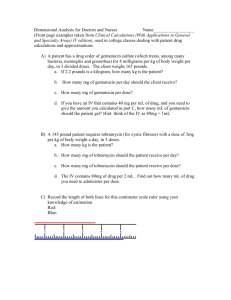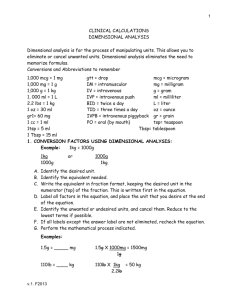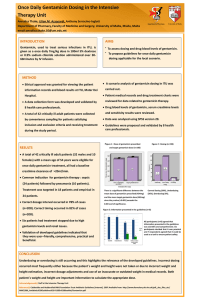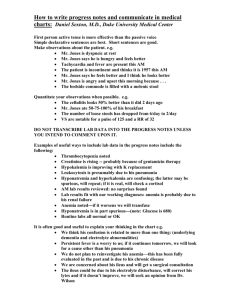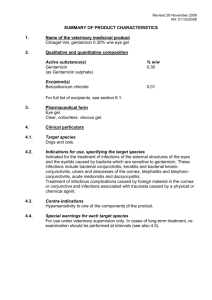Document 13308617
advertisement
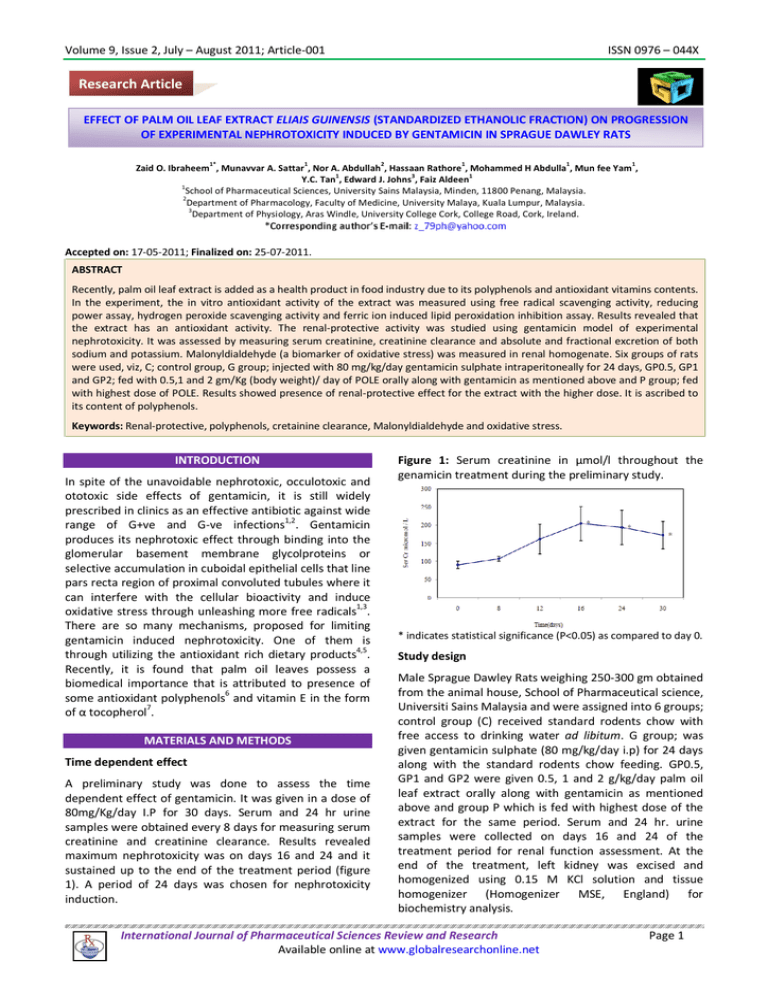
Volume 9, Issue 2, July – August 2011; Article-001 ISSN 0976 – 044X Research Article EFFECT OF PALM OIL LEAF EXTRACT ELIAIS GUINENSIS (STANDARDIZED ETHANOLIC FRACTION) ON PROGRESSION OF EXPERIMENTAL NEPHROTOXICITY INDUCED BY GENTAMICIN IN SPRAGUE DAWLEY RATS 1* 1 2 1 1 1 Zaid O. Ibraheem , Munavvar A. Sattar , Nor A. Abdullah , Hassaan Rathore , Mohammed H Abdulla , Mun fee Yam , 1 3 1 Y.C. Tan , Edward J. Johns , Faiz Aldeen 1 School of Pharmaceutical Sciences, University Sains Malaysia, Minden, 11800 Penang, Malaysia. 2 Department of Pharmacology, Faculty of Medicine, University Malaya, Kuala Lumpur, Malaysia. 3 Department of Physiology, Aras Windle, University College Cork, College Road, Cork, Ireland. Accepted on: 17-05-2011; Finalized on: 25-07-2011. ABSTRACT Recently, palm oil leaf extract is added as a health product in food industry due to its polyphenols and antioxidant vitamins contents. In the experiment, the in vitro antioxidant activity of the extract was measured using free radical scavenging activity, reducing power assay, hydrogen peroxide scavenging activity and ferric ion induced lipid peroxidation inhibition assay. Results revealed that the extract has an antioxidant activity. The renal-protective activity was studied using gentamicin model of experimental nephrotoxicity. It was assessed by measuring serum creatinine, creatinine clearance and absolute and fractional excretion of both sodium and potassium. Malonyldialdehyde (a biomarker of oxidative stress) was measured in renal homogenate. Six groups of rats were used, viz, C; control group, G group; injected with 80 mg/kg/day gentamicin sulphate intraperitoneally for 24 days, GP0.5, GP1 and GP2; fed with 0.5,1 and 2 gm/Kg (body weight)/ day of POLE orally along with gentamicin as mentioned above and P group; fed with highest dose of POLE. Results showed presence of renal-protective effect for the extract with the higher dose. It is ascribed to its content of polyphenols. Keywords: Renal-protective, polyphenols, cretainine clearance, Malonyldialdehyde and oxidative stress. INTRODUCTION In spite of the unavoidable nephrotoxic, occulotoxic and ototoxic side effects of gentamicin, it is still widely prescribed in clinics as an effective antibiotic against wide range of G+ve and G-ve infections1,2. Gentamicin produces its nephrotoxic effect through binding into the glomerular basement membrane glycolproteins or selective accumulation in cuboidal epithelial cells that line pars recta region of proximal convoluted tubules where it can interfere with the cellular bioactivity and induce oxidative stress through unleashing more free radicals1,3. There are so many mechanisms, proposed for limiting gentamicin induced nephrotoxicity. One of them is 4,5 through utilizing the antioxidant rich dietary products . Recently, it is found that palm oil leaves possess a biomedical importance that is attributed to presence of some antioxidant polyphenols6 and vitamin E in the form of α tocopherol7. MATERIALS AND METHODS Time dependent effect A preliminary study was done to assess the time dependent effect of gentamicin. It was given in a dose of 80mg/Kg/day I.P for 30 days. Serum and 24 hr urine samples were obtained every 8 days for measuring serum creatinine and creatinine clearance. Results revealed maximum nephrotoxicity was on days 16 and 24 and it sustained up to the end of the treatment period (figure 1). A period of 24 days was chosen for nephrotoxicity induction. Figure 1: Serum creatinine in µmol/l throughout the genamicin treatment during the preliminary study. * indicates statistical significance (P<0.05) as compared to day 0. Study design Male Sprague Dawley Rats weighing 250-300 gm obtained from the animal house, School of Pharmaceutical science, Universiti Sains Malaysia and were assigned into 6 groups; control group (C) received standard rodents chow with free access to drinking water ad libitum. G group; was given gentamicin sulphate (80 mg/kg/day i.p) for 24 days along with the standard rodents chow feeding. GP0.5, GP1 and GP2 were given 0.5, 1 and 2 g/kg/day palm oil leaf extract orally along with gentamicin as mentioned above and group P which is fed with highest dose of the extract for the same period. Serum and 24 hr. urine samples were collected on days 16 and 24 of the treatment period for renal function assessment. At the end of the treatment, left kidney was excised and homogenized using 0.15 M KCl solution and tissue homogenizer (Homogenizer MSE, England) for biochemistry analysis. International Journal of Pharmaceutical Sciences Review and Research Available online at www.globalresearchonline.net Page 1 Volume 9, Issue 2, July – August 2011; Article-001 The extract Ethanolic fraction of POLE was obtained from (NOVA). It was prepared by chopping and freeze drying of the fronds for 24 hours. After pulverizing the dried leaves the powder was soaked with absolute alcohol 1:20 (w/v) for two days. Then filtered and the residue was re-extracted twice. After that, it was dried till the solvent is completely removed. The final form of the extract was standardized using Folin Ciocalteu test for measuring the phenolic content and free radical scavenging activity (FRSA), hydrogen peroxide scavenging activity, reducing power assay and anti lipid peroxidation assay for assessing the antioxidant activity. In vitro assessment of antioxidant activity Total phenol content Total phenolic content was determined by using the modified method which is described by Singleton and 8 Rossi . Polyphenols react with Folin Ciocalteu reagent in the presence of saturated sodium carbonate solution to produce a complex whose λmax is 725 nm (Analytikijena 200-2004 spectrophotometer). Gallic acid (0.01–0.4 mM) was used to make the standard curve (0.01–0.4 mM). The results were expressed as mg of gallic acid equivalents/g of extract (GAEs). ISSN 0976 – 044X scavenging ability for each dilution was plotted. EC50 was deduced from the plot for the extract and compared to that of vitamin C and butylated hydroxytoluene (BHT)11. Anti-lipid peroxidation assay It was measured according to Kimuya Y, Kubo M, Tani T, Arichi S, Okuda H (1981). In which different concentrations of the extract, prepared by serial dilution, were incubated with a rat liver homogenate mixed with ferric chloride to induce lipid peroxidation. Finally, the antilipid peroxidation capacity of the extract was deduced by measuring the amount of MDA release with each concentration of the extract and compared with the control in which distill water was added instead of the extract12. Biochemical analysis Jaff reaction was used to estimate concentration of creatinine in urine and serum. Concentration of both sodium and potassium in urine were measured using flame photometer (Jenway PFP7). Creatinine clearance, absolute and fractional excretion of sodium and potassium were determined using the conventional equations. MDA concentration in renal homogenate was determined through the calorometric reaction between MDA and TBA (thiobarbituric acid). Free radical scavenging activity It was performed by assessing the ability of the extract to quench (DPPH) free radical (1, 1-diphenyl-2-picrylhydrazil) using method of Shimada, fujikawa, Yahara and Nakamura (1992). Eight dilutions of the extract were taken (1mg/ml solution of the extract was diluted serially) then 3 cc of each dilution was mixed with 1cc of 0.1M of DPPH dissolved in methanol. After 30 minutes, the absorbance of each dilution was measured at 517 nm and plotted against the concentration. EC50 (Extract concentration of that quenches 50% of DPPH) was calculated and compared to that of vitamin C and butylated hydroxytoluen (BHT)9. RESULTS Results of in vitro tests 1-DPPH scavenging activity POLE showed a concentration dependent antiradical activity by scavenging DPPH with a EC50=35 µgm/ml as compared to BHT and vitamin C whose EC50=11 & 18 µgm/ml respectively (figure 2). Figure 2: In vitro evaluation of free radical scavenging activity of the extract as compared to that of vitamin C and BHT. Reducing power assay It was measured according to method of Oyaizu (1986). In which, 1 mg/ml of the extract was diluted serially and each dilution was mixed with the mixture of Prussian blue. The reducing power of the extract is deduced from it's ability to intensify absorbance at 700 nm. The extract concentration verses percent of absorption was plotted. IC50 (the concentration of the antioxidant solution required to intensify the absorption by 50%) was calculated and compared with that of vitamin C and butylated hydroxytoluene (BHT) 10. Hydrogen peroxide scavenging activity It was determined by method of Oktay et al (2003). In which the ability of different concentrations of the extract prepared by serial dilution to quench hydrogen peroxide was measured using UV-spectrophotometer at a wavelength 230 nm. Percent of hydrogen peroxide The concentrations were ranging between 8 -125 µ g/ml. The data fit 2 the linear equation: Y=0.57X+21 (R =0.87) for POLE and were fitting the 2 2 equations Y=1.075X+29 (R =0.97) and Y=0.98+37 (R =0.83) for both vitamin C and BHT respectively. International Journal of Pharmaceutical Sciences Review and Research Available online at www.globalresearchonline.net Page 2 Volume 9, Issue 2, July – August 2011; Article-001 POLE has a concentration dependent potential for intensification the color of Prussian blue reaction as seen in figure 3. IC50 of the extract was 41 µgm/ml as compared to BHT and vitamin C whose IC50=2 & 4 µgm/ml respectively. Figure 3: In vitro evaluation of reducing power for the extract as compared to that of vitamin C and BHT. Figure 5: In vitro evaluation of antilipid peroxidation inhibition activity of the extract as compared to that of vitamin C. 100 80 % inhibition 2-Reducing power assay ISSN 0976 – 044X 60 40 20 0 0.008 0.016 0.032 0.064 0.125 0.25 0.5 1 POLE conc mg/ml POLE Vit C The concentrations were ranging between 8 µ g/ml – 1 mg/ml. The data 2 were fitting the linear equations: Y=65X+20.3 (R =0.79) and 2 Y=59.9X+46.6 (R =0.6) for POLE and vitamin C respectively. Kidney function tests The concentrations were ranging between 20 - 1250 µ g/ml. 3-Hydrogen peroxide scavenging activity POLE showed a concentration dependent potential for hydrogen peroxide scavenging activity as seen in figure 4. The extract showed a Hydrogen peroxide scavenging activity with EC50=72 µgm/ml as compared to vitamin C and BHT whose EC50 were 40 and 32 µgm/ml respectively. Figure 4: In vitro evaluation of hydrogen peroxide scavenging activity of the extract as compared to that of vitamin C and BHT. The concentrations were ranging between 8 - 1000 µg/ml. The data fit 2 the linear equation: Y=0.76X+7.25 (R =0.98) in the range from 8 - 125 2 µg/ml for POLE and were fitting the equations Y=0.45X+29.5 (R =0.98) 2 and Y=0.3+38.3 (R =0.95) for both vitamin C and BHT respectively. 4-Antilipid peroxidation inhibition assay Results of this test showed a potential of POLE to interfere with Fe3+ induced lipid peroxidation as it was evidenced through suppressing the release of MDA after incubating the homogenate with the extract. EC50 of the extract was 140 µg /ml as compared to vitamin C whose EC50 was 28 µg /ml (figure 5). The preliminary study showed that 80 mg/kg/day of gentamicin injection to Sprague Dawley rats induced nephrotoxicity which started on day 12, reached the climax on day 16 and stayed high up to the end of the treatment period (Figure 1). Gentamicin injection to Sprague Dawley rats in a dose 80 mg/kg/day intraperitoneally has raised serum creatinine by about two times and reduced the creatinine clearance to about half the control value on days 16 and 24 of the treatment period. From the other hand, Gentamicin interfered with the tubular function as seen in results of absolute and fractional excretion of both sodium and potassium. The increase was four times the control for fractional excretion of sodium on day 16 and about six times the control for potassium in that day. Values of fractional excretion for both sodium and potassium were about three times the control value on day 24. Values of serum sodium and potassium were not affected after gentamicin treatment. Co-administration of palm oil leaf extract along with gentamicin has reduced serum creatinine as compared to the positive control. The decrease was slight and stayed significantly higher as compared to the negative control after oral feeding of the rats with 0.5 and 1 g/kg/day .It was more noticeable and did not show any significance as compared to the negative control after feeding them with 2 g /kg/day. Values of creatinine clearance did not show any did not show any difference after feeding the rats with 0.5 and 1 g / kg / day with POLE while feeding the rats with 2 g/kg/day POLE has ameliorated them. POLE coadministration along with gentamicin did not produce any difference in values of absolute excretion of sodium and potassium in the three given doses. Values of fractional excretion were reduced after POLE co-administration and the decrease was more obvious in the group fed with 2 g/kg/day POLE along with gentamicin. Feeding the rats with 2 g/kg/day POLE alone for 24 days did not produce any nephrotoxic effect as it is obvious from results of serum creatinine and creatinine clearance. From the other hand a slight increase in urine flow rate International Journal of Pharmaceutical Sciences Review and Research Available online at www.globalresearchonline.net Page 3 Volume 9, Issue 2, July – August 2011; Article-001 and absolute excretion of electrolytes was observed. Although this increase did not show any statistical significance. Gentamicin administration has slightly raised the oxidative stress in renal tissue as seen in results of MDA (malonyldialdehyde) concentration in renal homogenate. It was reduced after POLE co-administration and reached to the value of the negative control for the group fed with 2 g/kg/ day POLE along with gentamicin. Feeding with 2 g/kg/day POLE alone did not produce any change in MDA concentration as compared to control (figure 6). Figure 6: MDA (Malonyldialdehyde) level in renal tissue. It is expressed in nmol/ g (kidney tissue). The data did not show any statistical significance among the groups. DISCUSSION AND CONSLUION Gentamicin is a nephrotoxic drug. It induces its nephrotoxicity through raising the oxidative stress in the cells of proximal convoluted tubules and triggering some structural changes in the glomerular basement membrane1,2. Period of time for nephrotoxicity induction and its strength depends on so many factors as the responsiveness of the animal’s renal tissue to aminoglycosides, degree of tissue regeneration potential for necrotized cells, time within the day when the dose is given and the nature of dietary supplements that the animal receives13. So it is very important to do a preliminary study for assessing the model of nephrotoxicity in the treated animals. Our preliminary study revealed that mild nephrotoxicity was induced after daily intraperitoneal injection with 80 mg/kg/day gentamicin sulphate. It reached the climax after 16 days and stayed high up to the end of the treatment period. There is a sequence of events in gentamicin induced nephrotoxicity. The story starts with uptake of gentamicin by the PCT cells by aid of certain brush border phospholipids for the endocytosis of gentamicin. After that gentamicin is stored inside the lysosome and then is released into the cytosol after reaching a threshold intralysosomal concentration and induction of lysosomal damage. When it is released to the cytosol, it’s damaging action starts. It characterized by both mitochondrial and basolateral membrane damage. This damage is responsible for inducing changes in renal tissue texture that lead to luminal occlusion by cast and cellular blebs. This action results in reduction of the GFR and decrease ISSN 0976 – 044X 1,2 the tubular function . The decrease in GFR is characterized by an exiguity of fluids transgress through the glomerular basement membrane. Creatinine clearance is one of the parameters, can be used to see that. Tubular function is assessed by measuring the urinary excretion of electrolytes reabsorbed by renal tubules. In acute renal failure, although there is a decrease in escape of fluids into renal tubules and a decrease in re-absorption of water and electrolytes which leads to polyurea in the initial stages. With progression of renal failure, the polyurea changes into oligurea14. Generally, gentamicin induced nephrotoxicity is an asynchronous type of nephrotoxicty (i.e. - the nephrotoxic effect does not develop synchronously in all nephrons)2. After the incidence of damage, a competition occur between two counteractive processes; the degenerative process induced by loaded gentamicin and the regenerative process which is attributed to the tissue's potential to regenerate or to counteract the damage induced by the degenerative factors. Progression of renal failure and pattern of changes in renal parameters relies 15 mainly on these factors Serum level of sodium and potassium did not show any change. Although in renal failure, urinary electrolyte excretion is increased, as depicted in (table 1). This may be attributed to the elaborate mechanisms that the body uses for maintaining the level of serum electrolytes16. The increase of absolute excretion of sodium indicates a defect in the ability of the tubular system to reabsorb sodium ion. Mostly this defect occurs either in PCT or DCT of nephrons. The kidneys try to limit this disturbance through activating aldosteron sensitive sodium potassium pump which leads to reabsorption of more sodium and release of more potassium. This disturbance is associated with polyurea due to the tendency of releasing an equamolar amount of water to the amount of salts lost. The results showed a correspondence in the amount of urine shed along with the amount of sodium excretion over a specified period of time17. The higher absolute excretion of sodium is attributed to decrease in tubular function but it does not indicate whether this decrease is attributed to tubular damage or it is just due to decrease in activity of transport mechanism. Meanwhile, the fractional excretion of electrolytes gives a better understanding about the extent of tubular damage18. Our results revealed that there is a pronounced increase in fractional excretion of sodium in gentamicin alone treated group as compared to the control. The larger fractional excretion means a greater damage in the tubular system. Feeding the rats with 2 gm/kg/day POLE along with gentamicin could have reduced fractional excretion of electrolytes and improved creatinine clearance. This indicated an improvement in tubular function. The increase in absolute excretion of potassium is attributed either to the decrease in the tubular reabsorption of electrolyte or may b due to the increase of potassium secretion by the aldosteron sensitive mechanism in the International Journal of Pharmaceutical Sciences Review and Research Available online at www.globalresearchonline.net Page 4 Volume 9, Issue 2, July – August 2011; Article-001 ISSN 0976 – 044X 16 collecting tubule portion of the tubular system . In our case we expect damage in PCT that hinders both sodium and potassium reabsorption and an increase in amount of sodium delivered to the collecting tubule portion of nephron which favors more potassium excretion. The absolute excretion of potassium was high in gentamicin alone and gentamicin and POLE treated groups. Fractional excretion was higher in these groups as compared to control but it was reduced in a high dose POLE treated group along with gentamicin. This indicates either an improvement of tubular function or less triggering of the sodium potassium pump at the late portion of nephron due to decrease in concentration of sodium at this portion. So this indicates that high dose of POLE feeding could have improved renal function through improving the creatinine clearance and the tubular function. Mechanism of gentamicin induced nephrotoxicity is attributed to its ability to elevate oxidative stress in renal tissue1. Measuring of oxidative stress biomarkers gives us an indication about the progression of the toxic effect of gentamicin. MDA value in renal tissue showed a higher increase in renal tissue of gentamicin alone treated group. It was reduced by different doses of POLE. This indicates that the extract feeding could have broken the chain oxidative reaction and limited the amount of free radical generated due to the pathological condition. Table 1: Renal function parameters for all the treated rats on days 16 and 24 Group UFR in µmol/min/100 g (B.W) + Abs Na in mmol/hr. + Abs K in mmol/hr. FE Na FE K CrCl/BW in ml/min.100 g (B.W Ser Cr. In µmol/l Abs Cr. Cl. In ml/min Ser Na in mmol/l Ser K In mmol/l C G G0.5 G1 G2 P2 16 2.22±0.22 § 4.40±0.60* 4.95±0.61* 4.30±0.64* 4.27±0.50* 2.72±0.25 § 24 2.17±0.11 § 4.17±0.27* 3.35±0.47 3.98±0.50* 3.67±0.24 2.60±0.24 16 0.017±0.002 § 0.036±0.005 * 0.039±0.009 0.036±0.007 0.036±0.003 0.022±0.002 24 0.019±0.002 0.036±0.003 0.030±0.006 0.037±0.006 0.035±0.004 0.024±0.004 16 0.08 ±0.009 § 0.18±0.028* 0.22±0.030* 0.16±0.021* 0.14±0.006 0.10±0.013 24 0.07±0.008 § 0.17 ±0.015* 0.14±0.023 0.14±0.018 0.16 ±0.018* 0.10±0.008 16 0.52±0.02 2.18±0.18 2.57±0.47 1.85±0.37 1.44±0.22 0.56±0.05 24 0.48±0.04 1.77±0.18 2.30±0.34 2.11±0.33 1.25±0.18 0.56±0.11 16 58±3 337±34 380±67 288±45 183±34 88±5 24 67±7 255±34 273±45 246±57 184±33 69±6 16 0.13 ±0.01 § 0.051±0.00 * 0.066±0.01 0.070±0.02 0.096±0.02 0.124±0.01 § 24 0.14±0.02 § 0.07±0.01* 0.05 ±0.01* 0.06 ±0.01* 0.10±0.01 0.14±0.01 16 81.1±3.9 § 203.7±17.4 * 191.0±19.7* 175.0±19.3* 134.8±12.0 87.7±6.2 § 24 91.7±6.2 § 182.0±12.5* 189.8±18.6* 176.8±15.1 126.7±9.3 88.2±7.5 § 16 0.36 ±0.05 0.21 ±0.01 0.18 ±0.04 0.19 ±0.04 0.26 ±0.05 0.34 ±0.02 24 0.42 ±0.07 0.19±0.02 * 0.15±0.02 * 0.17±0.03 * 0.27±0.03 0.39±0.04 16 138±3 133±3 127±2 130±3 130±3 131±2 24 134±2 126±2 131±3 127±2 127±2 128±2 16 5.3±0.2 5.6±0.8 5.7±0.2 5.6±0.2 5.7±0.2 4.8±0.3 24 5.1±0.2 5.7±0.7 5.7±0.2 6.1±0.3 5.6±0.3 5.7±0.4 All data are expresses as mean ± s.e.m. * indicates significantly different as compared to control (P<0.05) and § indicates significantly different as compared to G group. Acknowledgement: School of pharmacy/ Universiti Sains Malaysia is gratefully acknowledged for financial support. We also thank The Advance Medical and Dental Institute (AMDI) USM for technical support in the experiment. 2. Mingeot-Leciercoq, M.-P. T., P. M. "Aminoglycosides: Nephrotoxicity." Antimicrob. Agents Chemother., 43, 1999, 1003-1012. 3. Cojocel, C., Dociu, N., Maita, K., Sleight, S. D. & Hook, J. B. "Effects of aminoglycosides on glomerular permeability, tubular reabsorption, and intracellular catabolism of the cationic low-molecular-weight protein lysozyme." Toxicology and Applied Pharmacology, 68, 1983, 96-109. 4. Walker, P. D., And S.V.Shah. "Gentamicin enhanced production of hydrogen peroxide by renal cortical mitochondria." Am. J. Physiol. 253: 1987,C495-C499. REFERENCES 1. Lopez-Novoa, J. M., Quiros, Y., Vicente, L., Morales, A. I. & Lopez-Hernandez, F. J. "New insights into the mechanism of aminoglycoside nephrotoxicity: an integrative point of view." Kidney Int, 79, 2003, 33-45. International Journal of Pharmaceutical Sciences Review and Research Available online at www.globalresearchonline.net Page 5 Volume 9, Issue 2, July – August 2011; Article-001 ISSN 0976 – 044X 5. Williams, P. D., Holohan, P.D. & Ross, C.R. "Gentamicin nephrotoxicity II. Plasma membrane changes." Toxicology and Applied Pharmacology, 61, 1981,243-251. 6. Rosalina Tan, R. T., Mohamed, S.,Samaneh, G. F.,Noordin, M.M.,Goh, Y. M. and Manap, M.Y.A. "Polyphenol rich oil palm leaves extract reduce hyperglycaemia and lipid oxidation in STZ-rats." International Food Research Journal 18: 2011,179-188. 7. AR Alimon, B. N. A. "Vitamin E concentration in blood plasma of palm oil frond fed goats." Ann Zootech 44, 1995,307. 8. Singleton, V. L., & Rossi, J.A.JR. "Colorimetric of total phenolics with phosphomolybdic-phosphotungstic acid reagents." American Journal of Enology and Viticulture, 16, 1965,144-158. 9. Hristea, E. N. "scavenging the hydroxyl radical by 2,2diphenyl-1-picrylhydrazyl." ARKIVOC 2002 2, (ii), 2002,123132. 10. Gulcin, I., Bershvili, D. & Gepdiremen, A. "ntiradical and antioxidant activity of total anthocyanins from Perilla pankinensis decne." Journal of Ethnopharmacology, 101, 2005,287-293. 11. Zhenbao, J., Fei, T., Ling, G., Guanjun, T. & Xiaolin, D.. "Antioxidant properties of extracts from juemingzi (Cassia tora L.) evaluated in vitro." LWT - Food Science and Technology, 40, 2007,1072-1077. stamineus Benth. Standardized Extract " AJMC Volume: 35, Issue: 1,2007,pp. 115-126 13. Reiner, N. E., Bloxham, D. D. & Thompson, W. L. "Nephrotoxicity of gentamicin and tobramycin given once daily or continuously in dogs." Journal of Antimicrobial Chemotherapy, 4, 1978,85-101. 14. Bennett, W. M., Mcdougall, J., Potocnik, S., Wright, R. D. & Whitworth, J. A. " Renal handling and acute urinary electrolyte effects of aminoglycoside antibiotics: Use of a solitary renal autotransplant in the conscious sheep." Life Sciences, 32, 1983,205-212. 15. De Souza, V. B., Oliveira, R. F. L. D., Lucena, H. F. D., Ferreira, A. A. A., Guerra, G. C. B., Freitas, M. D. L., Queiroz, K. C. D. S. & DE Araujo Junior, R.F. "Gentamicin Induces Renal Morphopathology in Wistar Rats." International Journal of Morphology, 27, 2009,59-63. 16. Zennaro, M.-C., Caprio, M. & Feve, B. "Mineralocorticoid receptors in the metabolic syndrome." Trends in Endocrinology & Metabolism, 20, 2009, 444-451. 17. Strihou, C. v. Y. d. "Potassium homeostasis in renal failure." Kidney International 11, 1977, 491–504. 18. Hervé P. Lefebvre, O. D., Catherine Trumel, Jean-Pierre Braun. "Fractional excretion tests: a critical review of methods and applications in domestic animals." Veterinary Clinical Pathology volume 37, issue 1, 2008, pages 4–20. 12. Mun Fei Yam, R. B., Mohd. Zaini Asmawi, Zhari Ismail. "Antioxidant and Hepatoprotective Effects of Orthosiphon *************** International Journal of Pharmaceutical Sciences Review and Research Available online at www.globalresearchonline.net Page 6
